RES300 Research Proposal: Air Pollution in High Population Countries
VerifiedAdded on 2023/06/15
|17
|3223
|330
Report
AI Summary
This research proposal investigates air pollution in high population countries, focusing on its impact and significance. It outlines the problem statement, methodologies (qualitative and quantitative data, primary and secondary sources, sampling techniques), ethical considerations, anticipated outcomes, and limitations. The proposal highlights the importance of understanding the relationship between population density, economic development, and air quality, especially in developing Asian countries. It also reflects on personal learning experiences during the research process and concludes with recommendations for controlling air pollution. Desklib provides access to this and other solved assignments to aid students in their studies.
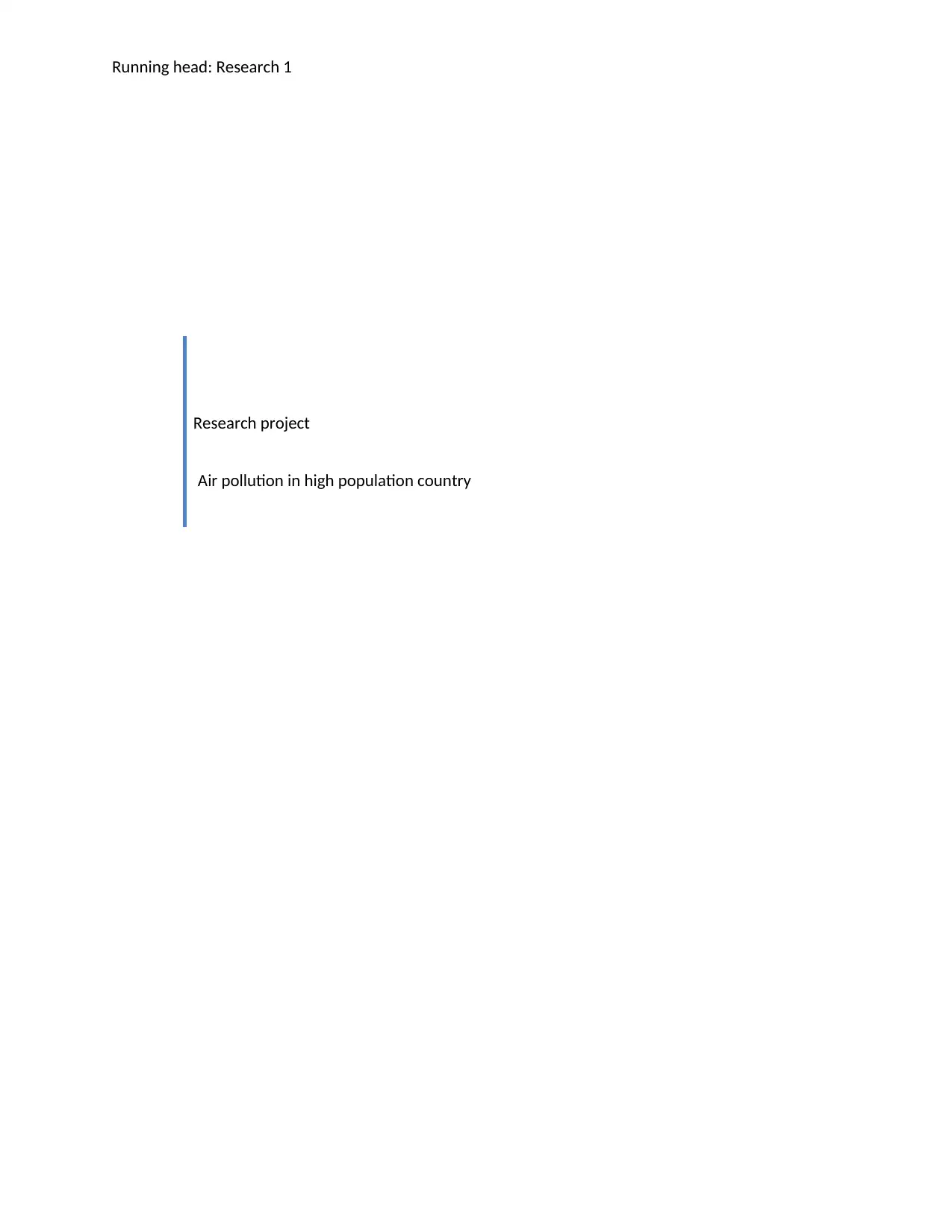
Running head: Research 1
Research project
Air pollution in high population country
Research project
Air pollution in high population country
Secure Best Marks with AI Grader
Need help grading? Try our AI Grader for instant feedback on your assignments.
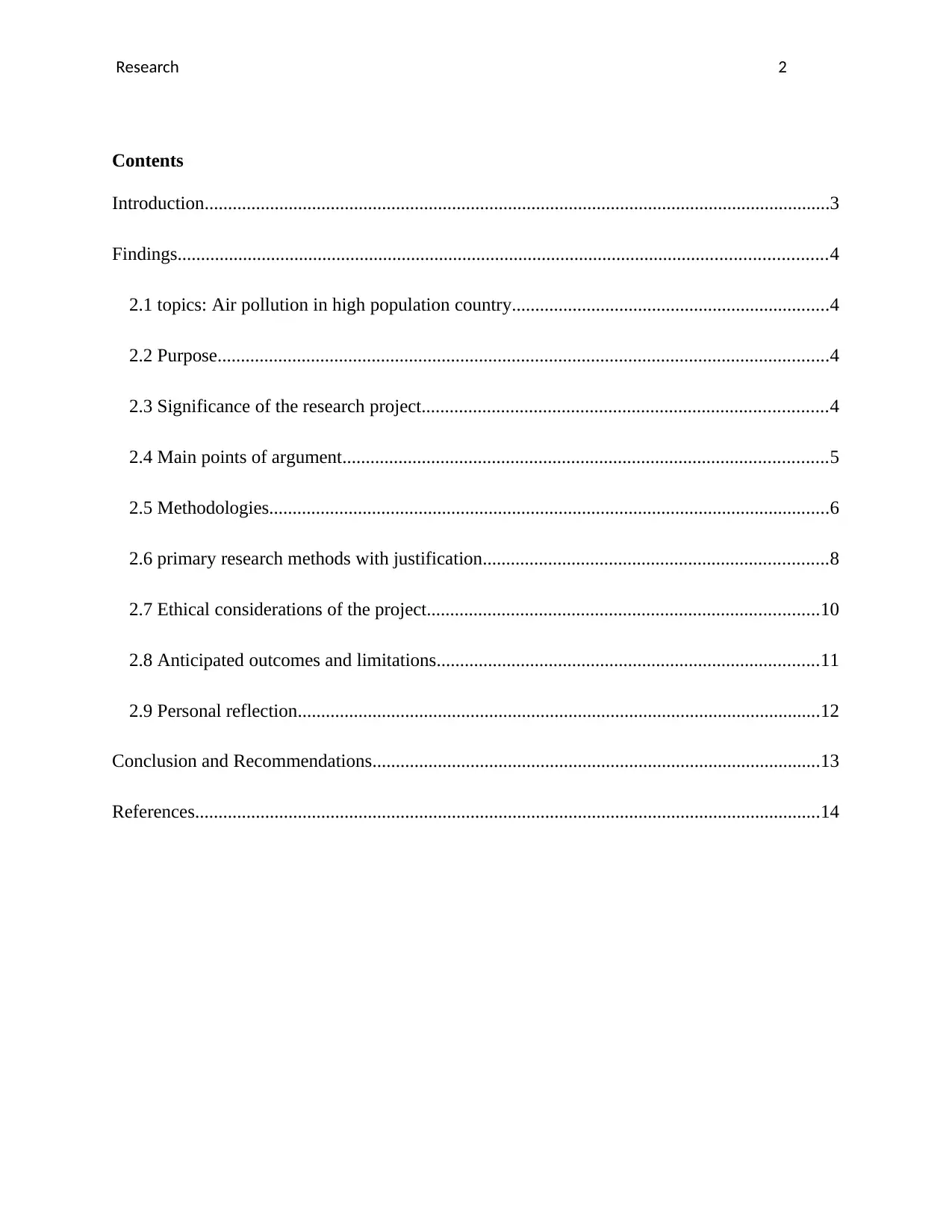
Research 2
Contents
Introduction......................................................................................................................................3
Findings...........................................................................................................................................4
2.1 topics: Air pollution in high population country....................................................................4
2.2 Purpose...................................................................................................................................4
2.3 Significance of the research project.......................................................................................4
2.4 Main points of argument........................................................................................................5
2.5 Methodologies........................................................................................................................6
2.6 primary research methods with justification..........................................................................8
2.7 Ethical considerations of the project....................................................................................10
2.8 Anticipated outcomes and limitations..................................................................................11
2.9 Personal reflection................................................................................................................12
Conclusion and Recommendations................................................................................................13
References......................................................................................................................................14
Contents
Introduction......................................................................................................................................3
Findings...........................................................................................................................................4
2.1 topics: Air pollution in high population country....................................................................4
2.2 Purpose...................................................................................................................................4
2.3 Significance of the research project.......................................................................................4
2.4 Main points of argument........................................................................................................5
2.5 Methodologies........................................................................................................................6
2.6 primary research methods with justification..........................................................................8
2.7 Ethical considerations of the project....................................................................................10
2.8 Anticipated outcomes and limitations..................................................................................11
2.9 Personal reflection................................................................................................................12
Conclusion and Recommendations................................................................................................13
References......................................................................................................................................14
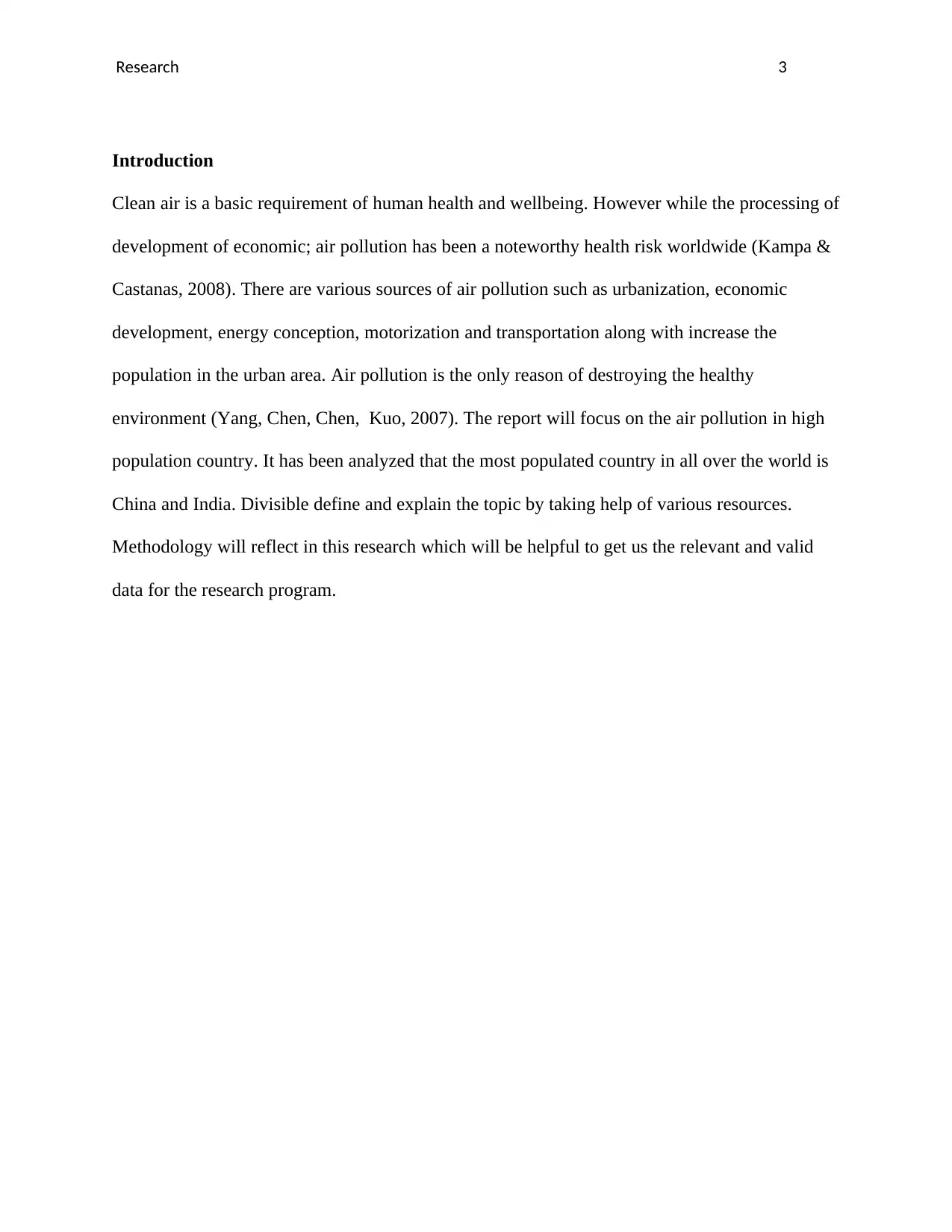
Research 3
Introduction
Clean air is a basic requirement of human health and wellbeing. However while the processing of
development of economic; air pollution has been a noteworthy health risk worldwide (Kampa &
Castanas, 2008). There are various sources of air pollution such as urbanization, economic
development, energy conception, motorization and transportation along with increase the
population in the urban area. Air pollution is the only reason of destroying the healthy
environment (Yang, Chen, Chen, Kuo, 2007). The report will focus on the air pollution in high
population country. It has been analyzed that the most populated country in all over the world is
China and India. Divisible define and explain the topic by taking help of various resources.
Methodology will reflect in this research which will be helpful to get us the relevant and valid
data for the research program.
Introduction
Clean air is a basic requirement of human health and wellbeing. However while the processing of
development of economic; air pollution has been a noteworthy health risk worldwide (Kampa &
Castanas, 2008). There are various sources of air pollution such as urbanization, economic
development, energy conception, motorization and transportation along with increase the
population in the urban area. Air pollution is the only reason of destroying the healthy
environment (Yang, Chen, Chen, Kuo, 2007). The report will focus on the air pollution in high
population country. It has been analyzed that the most populated country in all over the world is
China and India. Divisible define and explain the topic by taking help of various resources.
Methodology will reflect in this research which will be helpful to get us the relevant and valid
data for the research program.
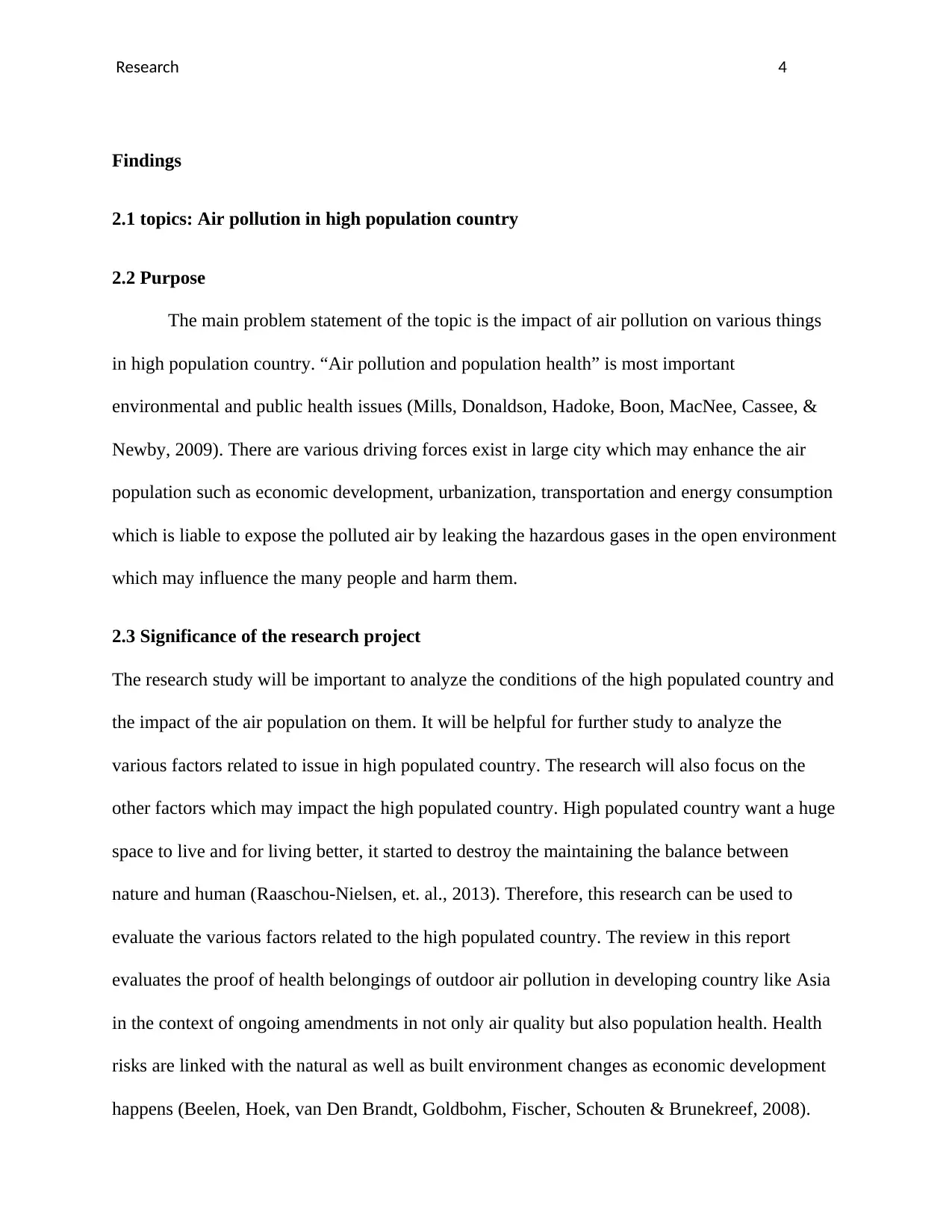
Research 4
Findings
2.1 topics: Air pollution in high population country
2.2 Purpose
The main problem statement of the topic is the impact of air pollution on various things
in high population country. “Air pollution and population health” is most important
environmental and public health issues (Mills, Donaldson, Hadoke, Boon, MacNee, Cassee, &
Newby, 2009). There are various driving forces exist in large city which may enhance the air
population such as economic development, urbanization, transportation and energy consumption
which is liable to expose the polluted air by leaking the hazardous gases in the open environment
which may influence the many people and harm them.
2.3 Significance of the research project
The research study will be important to analyze the conditions of the high populated country and
the impact of the air population on them. It will be helpful for further study to analyze the
various factors related to issue in high populated country. The research will also focus on the
other factors which may impact the high populated country. High populated country want a huge
space to live and for living better, it started to destroy the maintaining the balance between
nature and human (Raaschou-Nielsen, et. al., 2013). Therefore, this research can be used to
evaluate the various factors related to the high populated country. The review in this report
evaluates the proof of health belongings of outdoor air pollution in developing country like Asia
in the context of ongoing amendments in not only air quality but also population health. Health
risks are linked with the natural as well as built environment changes as economic development
happens (Beelen, Hoek, van Den Brandt, Goldbohm, Fischer, Schouten & Brunekreef, 2008).
Findings
2.1 topics: Air pollution in high population country
2.2 Purpose
The main problem statement of the topic is the impact of air pollution on various things
in high population country. “Air pollution and population health” is most important
environmental and public health issues (Mills, Donaldson, Hadoke, Boon, MacNee, Cassee, &
Newby, 2009). There are various driving forces exist in large city which may enhance the air
population such as economic development, urbanization, transportation and energy consumption
which is liable to expose the polluted air by leaking the hazardous gases in the open environment
which may influence the many people and harm them.
2.3 Significance of the research project
The research study will be important to analyze the conditions of the high populated country and
the impact of the air population on them. It will be helpful for further study to analyze the
various factors related to issue in high populated country. The research will also focus on the
other factors which may impact the high populated country. High populated country want a huge
space to live and for living better, it started to destroy the maintaining the balance between
nature and human (Raaschou-Nielsen, et. al., 2013). Therefore, this research can be used to
evaluate the various factors related to the high populated country. The review in this report
evaluates the proof of health belongings of outdoor air pollution in developing country like Asia
in the context of ongoing amendments in not only air quality but also population health. Health
risks are linked with the natural as well as built environment changes as economic development
happens (Beelen, Hoek, van Den Brandt, Goldbohm, Fischer, Schouten & Brunekreef, 2008).
Secure Best Marks with AI Grader
Need help grading? Try our AI Grader for instant feedback on your assignments.
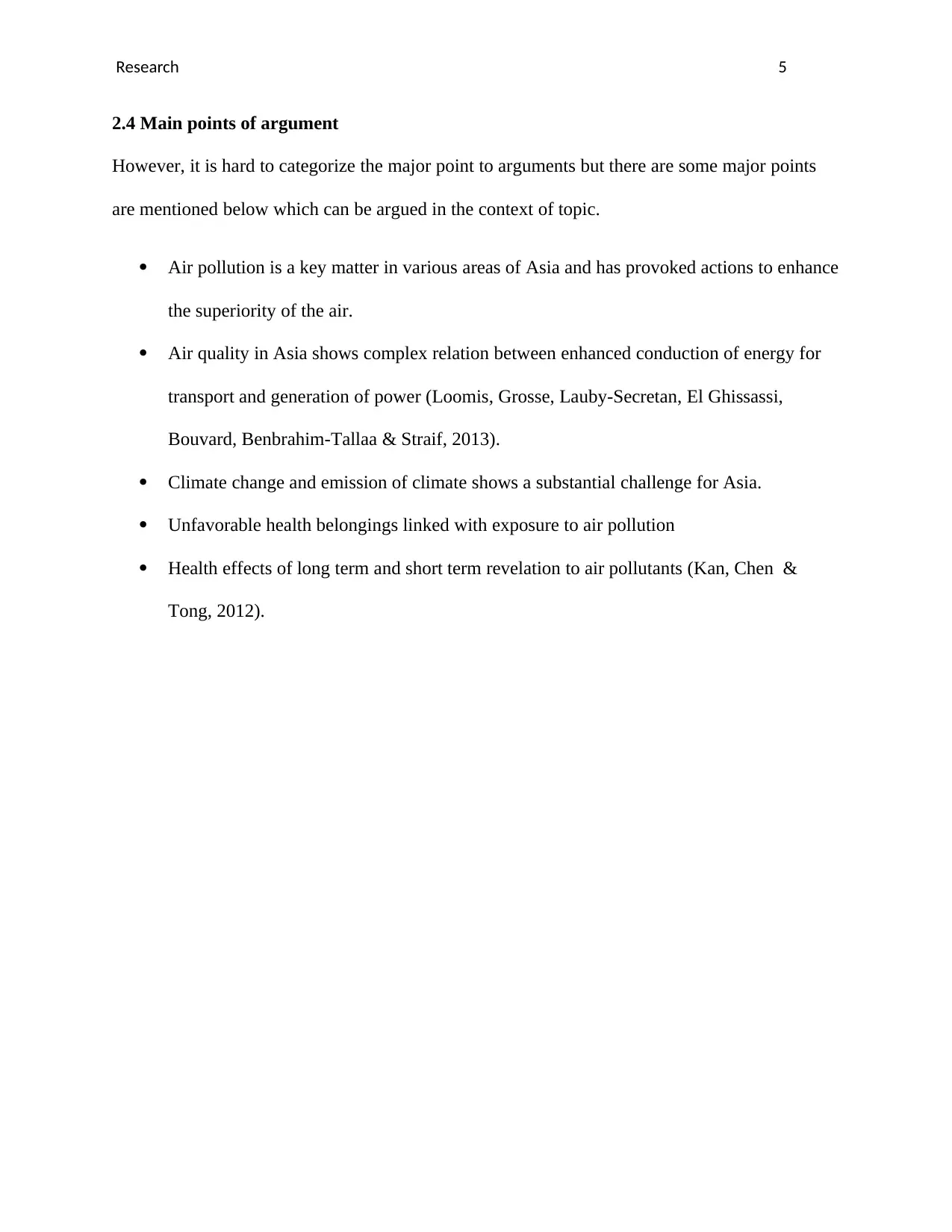
Research 5
2.4 Main points of argument
However, it is hard to categorize the major point to arguments but there are some major points
are mentioned below which can be argued in the context of topic.
Air pollution is a key matter in various areas of Asia and has provoked actions to enhance
the superiority of the air.
Air quality in Asia shows complex relation between enhanced conduction of energy for
transport and generation of power (Loomis, Grosse, Lauby-Secretan, El Ghissassi,
Bouvard, Benbrahim-Tallaa & Straif, 2013).
Climate change and emission of climate shows a substantial challenge for Asia.
Unfavorable health belongings linked with exposure to air pollution
Health effects of long term and short term revelation to air pollutants (Kan, Chen &
Tong, 2012).
2.4 Main points of argument
However, it is hard to categorize the major point to arguments but there are some major points
are mentioned below which can be argued in the context of topic.
Air pollution is a key matter in various areas of Asia and has provoked actions to enhance
the superiority of the air.
Air quality in Asia shows complex relation between enhanced conduction of energy for
transport and generation of power (Loomis, Grosse, Lauby-Secretan, El Ghissassi,
Bouvard, Benbrahim-Tallaa & Straif, 2013).
Climate change and emission of climate shows a substantial challenge for Asia.
Unfavorable health belongings linked with exposure to air pollution
Health effects of long term and short term revelation to air pollutants (Kan, Chen &
Tong, 2012).
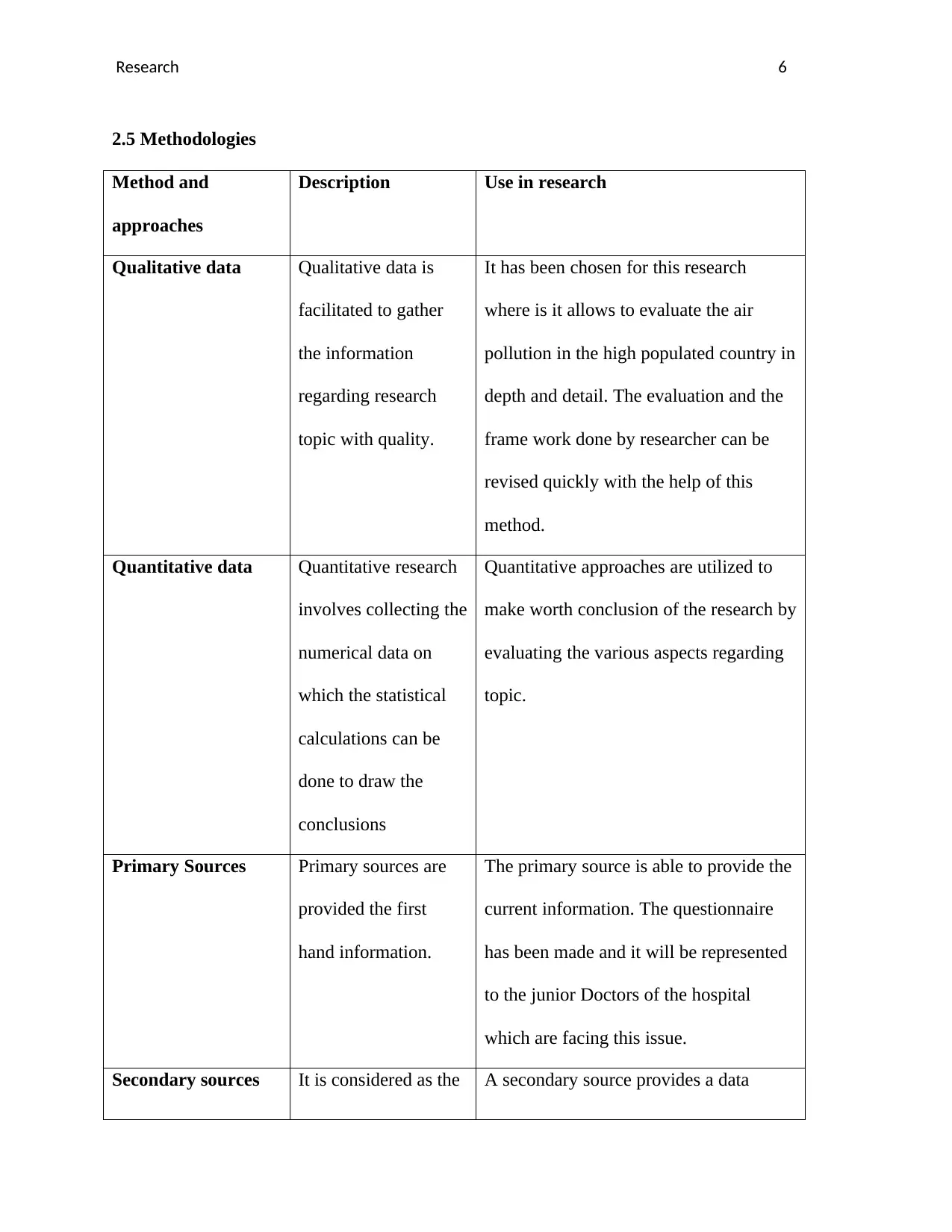
Research 6
2.5 Methodologies
Method and
approaches
Description Use in research
Qualitative data Qualitative data is
facilitated to gather
the information
regarding research
topic with quality.
It has been chosen for this research
where is it allows to evaluate the air
pollution in the high populated country in
depth and detail. The evaluation and the
frame work done by researcher can be
revised quickly with the help of this
method.
Quantitative data Quantitative research
involves collecting the
numerical data on
which the statistical
calculations can be
done to draw the
conclusions
Quantitative approaches are utilized to
make worth conclusion of the research by
evaluating the various aspects regarding
topic.
Primary Sources Primary sources are
provided the first
hand information.
The primary source is able to provide the
current information. The questionnaire
has been made and it will be represented
to the junior Doctors of the hospital
which are facing this issue.
Secondary sources It is considered as the A secondary source provides a data
2.5 Methodologies
Method and
approaches
Description Use in research
Qualitative data Qualitative data is
facilitated to gather
the information
regarding research
topic with quality.
It has been chosen for this research
where is it allows to evaluate the air
pollution in the high populated country in
depth and detail. The evaluation and the
frame work done by researcher can be
revised quickly with the help of this
method.
Quantitative data Quantitative research
involves collecting the
numerical data on
which the statistical
calculations can be
done to draw the
conclusions
Quantitative approaches are utilized to
make worth conclusion of the research by
evaluating the various aspects regarding
topic.
Primary Sources Primary sources are
provided the first
hand information.
The primary source is able to provide the
current information. The questionnaire
has been made and it will be represented
to the junior Doctors of the hospital
which are facing this issue.
Secondary sources It is considered as the A secondary source provides a data
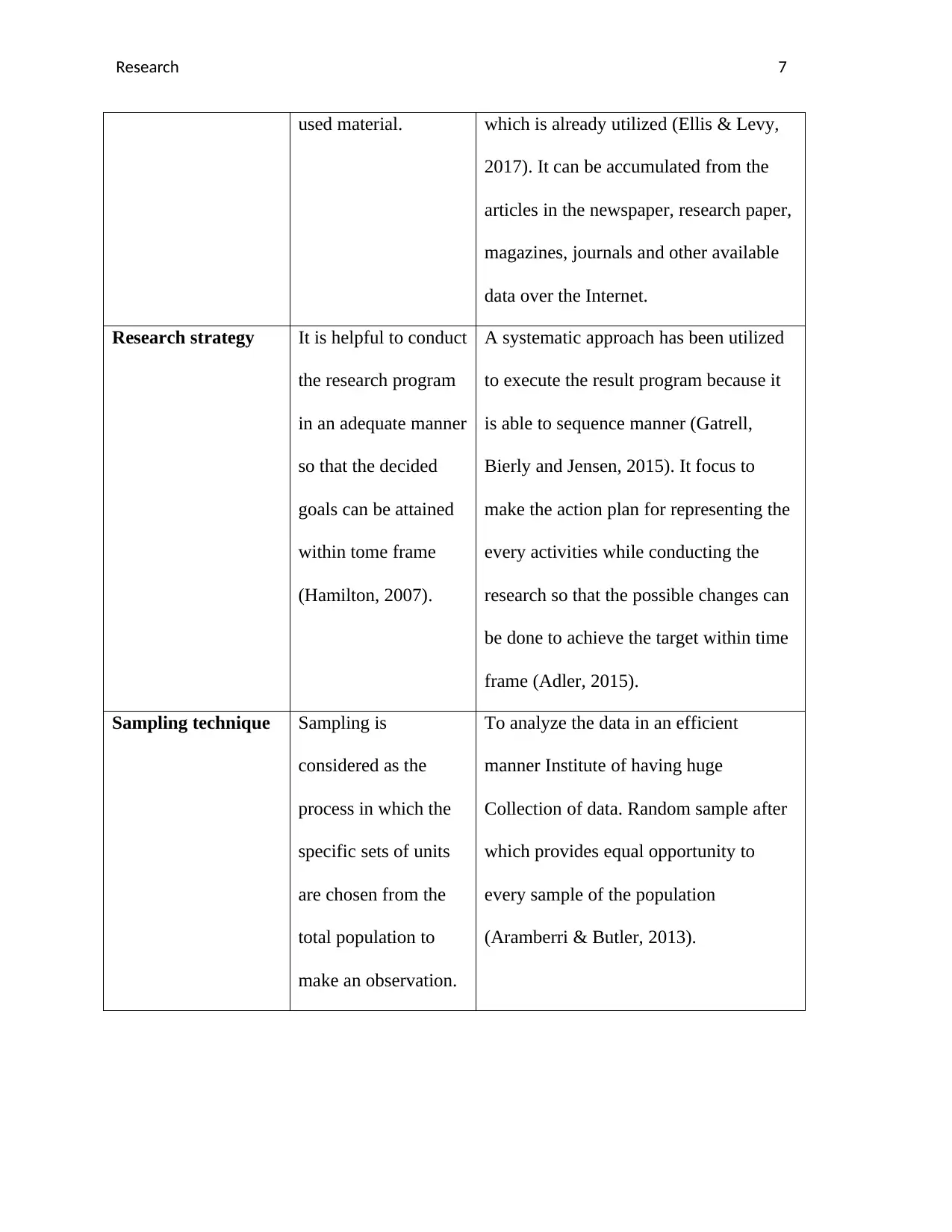
Research 7
used material. which is already utilized (Ellis & Levy,
2017). It can be accumulated from the
articles in the newspaper, research paper,
magazines, journals and other available
data over the Internet.
Research strategy It is helpful to conduct
the research program
in an adequate manner
so that the decided
goals can be attained
within tome frame
(Hamilton, 2007).
A systematic approach has been utilized
to execute the result program because it
is able to sequence manner (Gatrell,
Bierly and Jensen, 2015). It focus to
make the action plan for representing the
every activities while conducting the
research so that the possible changes can
be done to achieve the target within time
frame (Adler, 2015).
Sampling technique Sampling is
considered as the
process in which the
specific sets of units
are chosen from the
total population to
make an observation.
To analyze the data in an efficient
manner Institute of having huge
Collection of data. Random sample after
which provides equal opportunity to
every sample of the population
(Aramberri & Butler, 2013).
used material. which is already utilized (Ellis & Levy,
2017). It can be accumulated from the
articles in the newspaper, research paper,
magazines, journals and other available
data over the Internet.
Research strategy It is helpful to conduct
the research program
in an adequate manner
so that the decided
goals can be attained
within tome frame
(Hamilton, 2007).
A systematic approach has been utilized
to execute the result program because it
is able to sequence manner (Gatrell,
Bierly and Jensen, 2015). It focus to
make the action plan for representing the
every activities while conducting the
research so that the possible changes can
be done to achieve the target within time
frame (Adler, 2015).
Sampling technique Sampling is
considered as the
process in which the
specific sets of units
are chosen from the
total population to
make an observation.
To analyze the data in an efficient
manner Institute of having huge
Collection of data. Random sample after
which provides equal opportunity to
every sample of the population
(Aramberri & Butler, 2013).
Paraphrase This Document
Need a fresh take? Get an instant paraphrase of this document with our AI Paraphraser
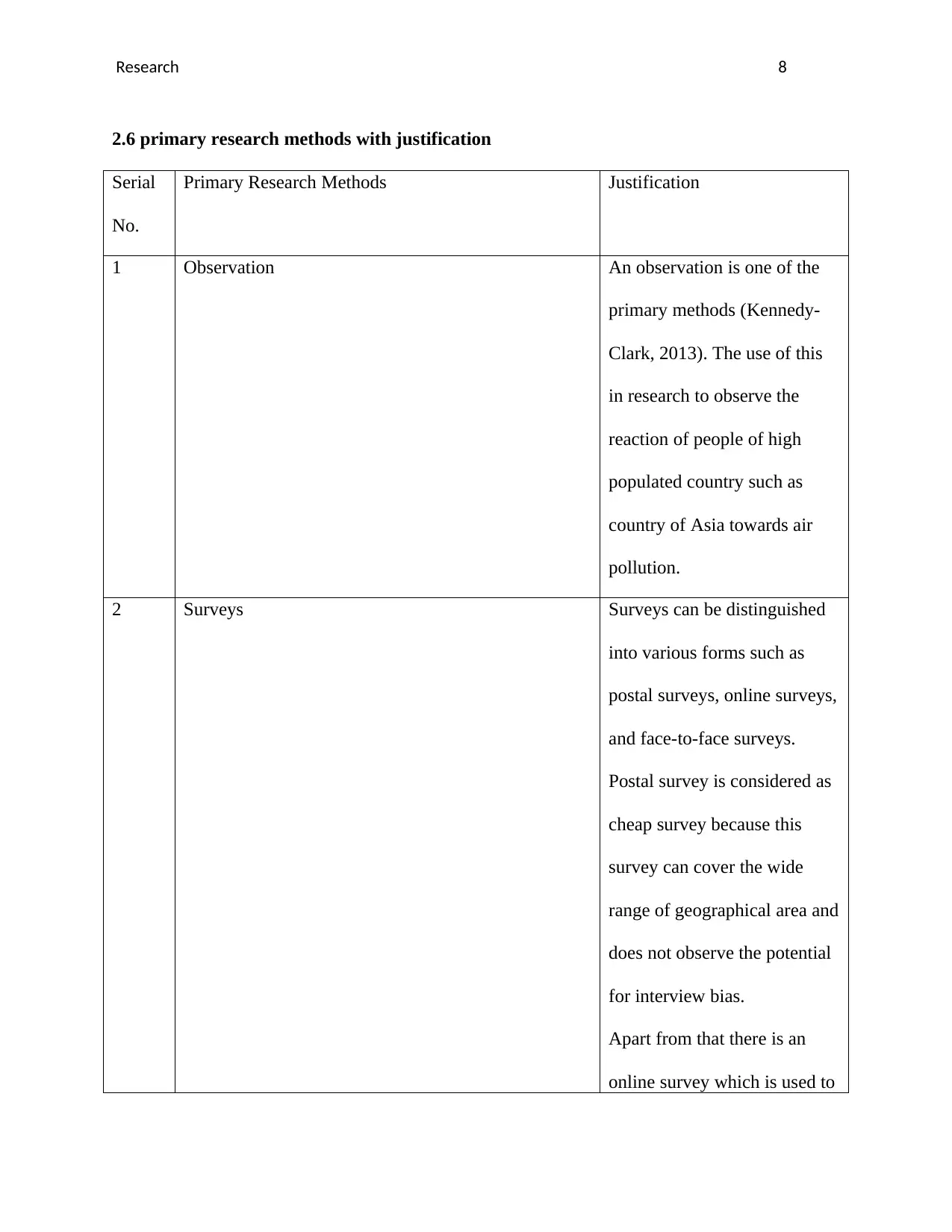
Research 8
2.6 primary research methods with justification
Serial
No.
Primary Research Methods Justification
1 Observation An observation is one of the
primary methods (Kennedy-
Clark, 2013). The use of this
in research to observe the
reaction of people of high
populated country such as
country of Asia towards air
pollution.
2 Surveys Surveys can be distinguished
into various forms such as
postal surveys, online surveys,
and face-to-face surveys.
Postal survey is considered as
cheap survey because this
survey can cover the wide
range of geographical area and
does not observe the potential
for interview bias.
Apart from that there is an
online survey which is used to
2.6 primary research methods with justification
Serial
No.
Primary Research Methods Justification
1 Observation An observation is one of the
primary methods (Kennedy-
Clark, 2013). The use of this
in research to observe the
reaction of people of high
populated country such as
country of Asia towards air
pollution.
2 Surveys Surveys can be distinguished
into various forms such as
postal surveys, online surveys,
and face-to-face surveys.
Postal survey is considered as
cheap survey because this
survey can cover the wide
range of geographical area and
does not observe the potential
for interview bias.
Apart from that there is an
online survey which is used to
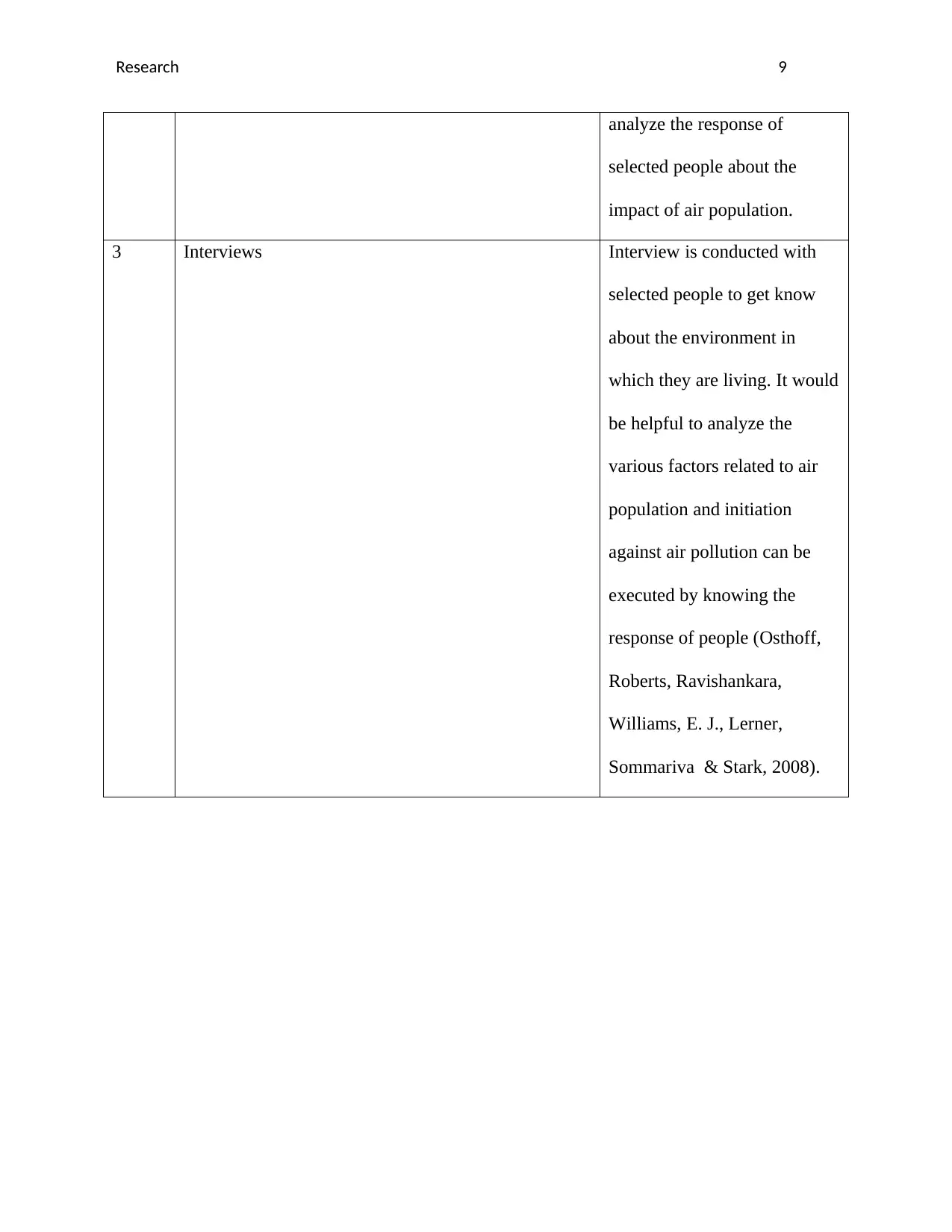
Research 9
analyze the response of
selected people about the
impact of air population.
3 Interviews Interview is conducted with
selected people to get know
about the environment in
which they are living. It would
be helpful to analyze the
various factors related to air
population and initiation
against air pollution can be
executed by knowing the
response of people (Osthoff,
Roberts, Ravishankara,
Williams, E. J., Lerner,
Sommariva & Stark, 2008).
analyze the response of
selected people about the
impact of air population.
3 Interviews Interview is conducted with
selected people to get know
about the environment in
which they are living. It would
be helpful to analyze the
various factors related to air
population and initiation
against air pollution can be
executed by knowing the
response of people (Osthoff,
Roberts, Ravishankara,
Williams, E. J., Lerner,
Sommariva & Stark, 2008).
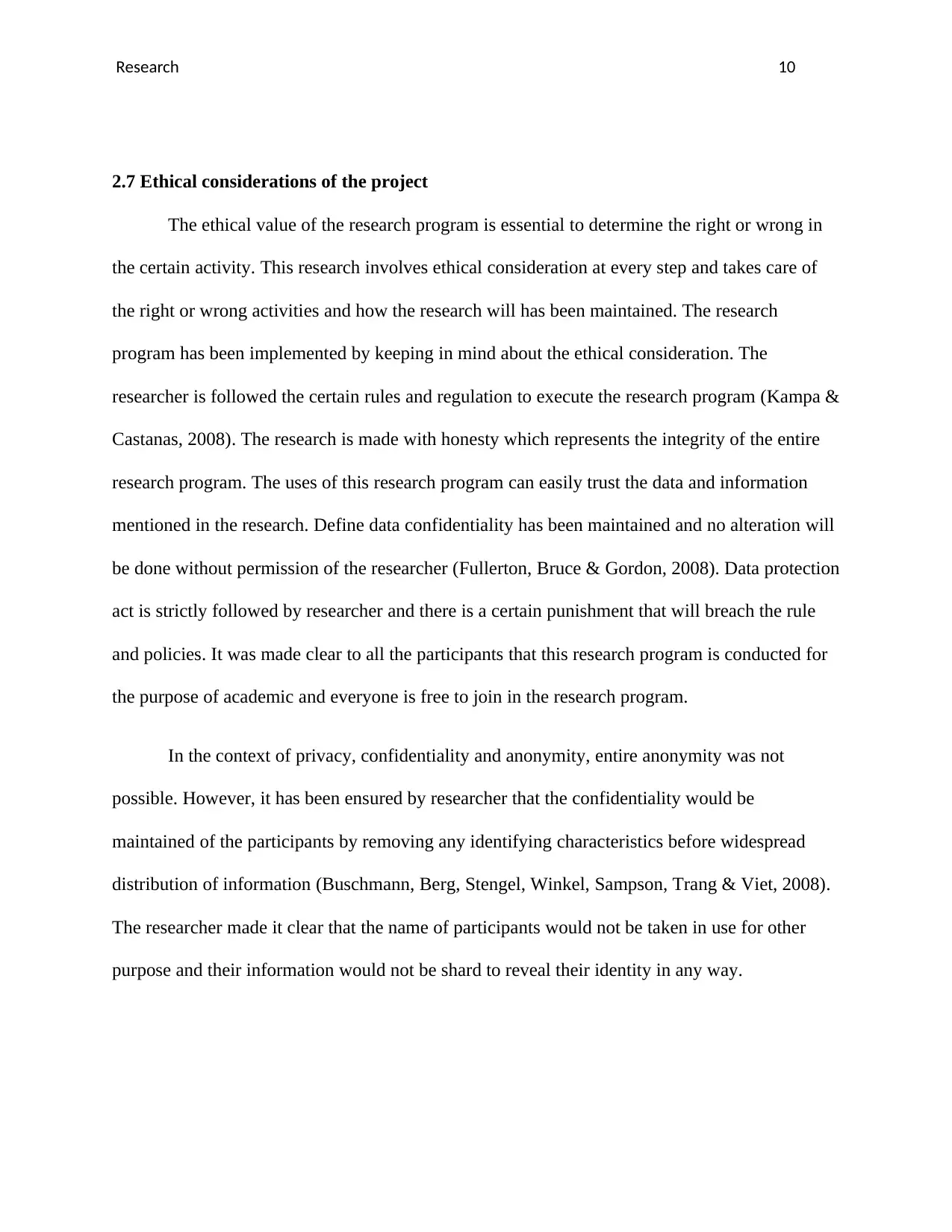
Research 10
2.7 Ethical considerations of the project
The ethical value of the research program is essential to determine the right or wrong in
the certain activity. This research involves ethical consideration at every step and takes care of
the right or wrong activities and how the research will has been maintained. The research
program has been implemented by keeping in mind about the ethical consideration. The
researcher is followed the certain rules and regulation to execute the research program (Kampa &
Castanas, 2008). The research is made with honesty which represents the integrity of the entire
research program. The uses of this research program can easily trust the data and information
mentioned in the research. Define data confidentiality has been maintained and no alteration will
be done without permission of the researcher (Fullerton, Bruce & Gordon, 2008). Data protection
act is strictly followed by researcher and there is a certain punishment that will breach the rule
and policies. It was made clear to all the participants that this research program is conducted for
the purpose of academic and everyone is free to join in the research program.
In the context of privacy, confidentiality and anonymity, entire anonymity was not
possible. However, it has been ensured by researcher that the confidentiality would be
maintained of the participants by removing any identifying characteristics before widespread
distribution of information (Buschmann, Berg, Stengel, Winkel, Sampson, Trang & Viet, 2008).
The researcher made it clear that the name of participants would not be taken in use for other
purpose and their information would not be shard to reveal their identity in any way.
2.7 Ethical considerations of the project
The ethical value of the research program is essential to determine the right or wrong in
the certain activity. This research involves ethical consideration at every step and takes care of
the right or wrong activities and how the research will has been maintained. The research
program has been implemented by keeping in mind about the ethical consideration. The
researcher is followed the certain rules and regulation to execute the research program (Kampa &
Castanas, 2008). The research is made with honesty which represents the integrity of the entire
research program. The uses of this research program can easily trust the data and information
mentioned in the research. Define data confidentiality has been maintained and no alteration will
be done without permission of the researcher (Fullerton, Bruce & Gordon, 2008). Data protection
act is strictly followed by researcher and there is a certain punishment that will breach the rule
and policies. It was made clear to all the participants that this research program is conducted for
the purpose of academic and everyone is free to join in the research program.
In the context of privacy, confidentiality and anonymity, entire anonymity was not
possible. However, it has been ensured by researcher that the confidentiality would be
maintained of the participants by removing any identifying characteristics before widespread
distribution of information (Buschmann, Berg, Stengel, Winkel, Sampson, Trang & Viet, 2008).
The researcher made it clear that the name of participants would not be taken in use for other
purpose and their information would not be shard to reveal their identity in any way.
Secure Best Marks with AI Grader
Need help grading? Try our AI Grader for instant feedback on your assignments.
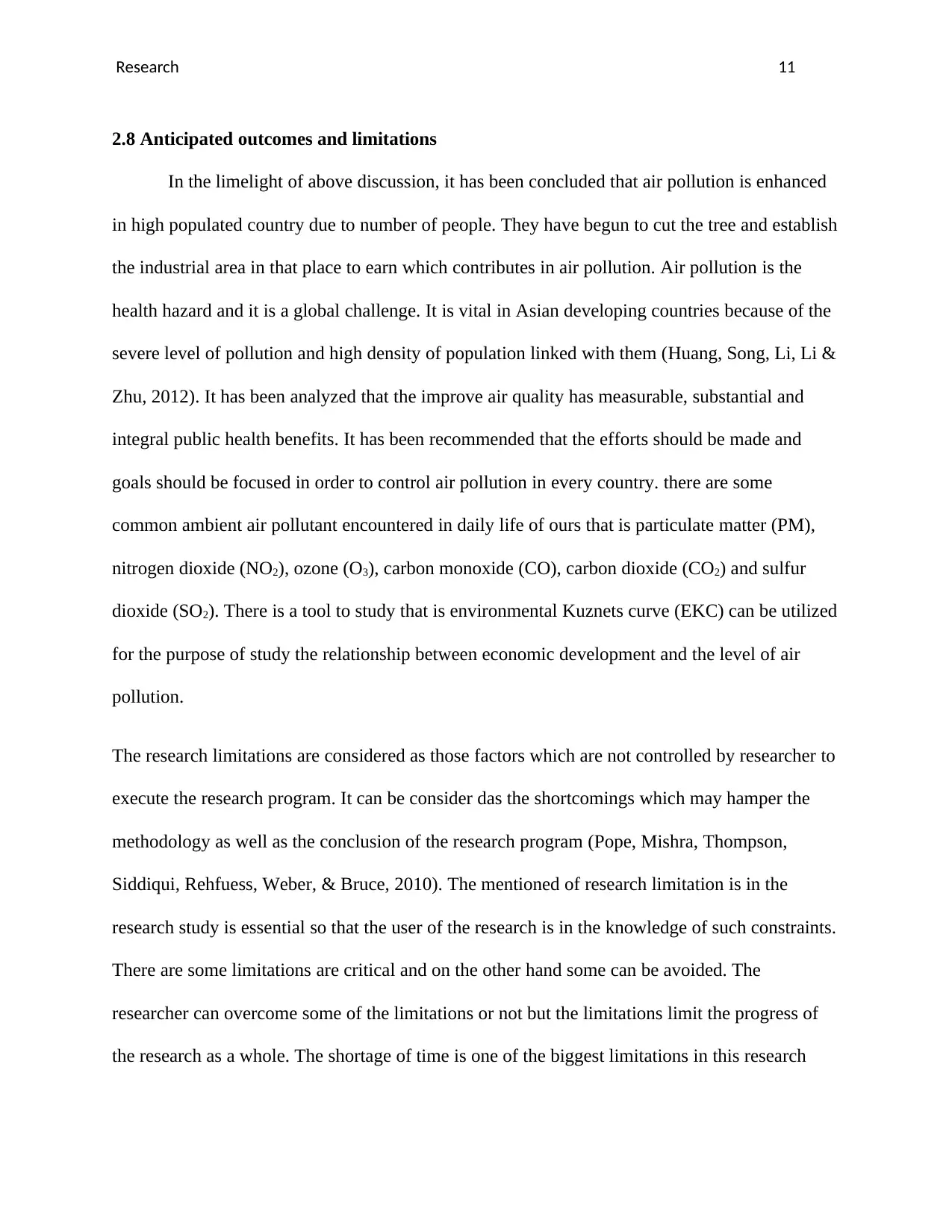
Research 11
2.8 Anticipated outcomes and limitations
In the limelight of above discussion, it has been concluded that air pollution is enhanced
in high populated country due to number of people. They have begun to cut the tree and establish
the industrial area in that place to earn which contributes in air pollution. Air pollution is the
health hazard and it is a global challenge. It is vital in Asian developing countries because of the
severe level of pollution and high density of population linked with them (Huang, Song, Li, Li &
Zhu, 2012). It has been analyzed that the improve air quality has measurable, substantial and
integral public health benefits. It has been recommended that the efforts should be made and
goals should be focused in order to control air pollution in every country. there are some
common ambient air pollutant encountered in daily life of ours that is particulate matter (PM),
nitrogen dioxide (NO2), ozone (O3), carbon monoxide (CO), carbon dioxide (CO2) and sulfur
dioxide (SO2). There is a tool to study that is environmental Kuznets curve (EKC) can be utilized
for the purpose of study the relationship between economic development and the level of air
pollution.
The research limitations are considered as those factors which are not controlled by researcher to
execute the research program. It can be consider das the shortcomings which may hamper the
methodology as well as the conclusion of the research program (Pope, Mishra, Thompson,
Siddiqui, Rehfuess, Weber, & Bruce, 2010). The mentioned of research limitation is in the
research study is essential so that the user of the research is in the knowledge of such constraints.
There are some limitations are critical and on the other hand some can be avoided. The
researcher can overcome some of the limitations or not but the limitations limit the progress of
the research as a whole. The shortage of time is one of the biggest limitations in this research
2.8 Anticipated outcomes and limitations
In the limelight of above discussion, it has been concluded that air pollution is enhanced
in high populated country due to number of people. They have begun to cut the tree and establish
the industrial area in that place to earn which contributes in air pollution. Air pollution is the
health hazard and it is a global challenge. It is vital in Asian developing countries because of the
severe level of pollution and high density of population linked with them (Huang, Song, Li, Li &
Zhu, 2012). It has been analyzed that the improve air quality has measurable, substantial and
integral public health benefits. It has been recommended that the efforts should be made and
goals should be focused in order to control air pollution in every country. there are some
common ambient air pollutant encountered in daily life of ours that is particulate matter (PM),
nitrogen dioxide (NO2), ozone (O3), carbon monoxide (CO), carbon dioxide (CO2) and sulfur
dioxide (SO2). There is a tool to study that is environmental Kuznets curve (EKC) can be utilized
for the purpose of study the relationship between economic development and the level of air
pollution.
The research limitations are considered as those factors which are not controlled by researcher to
execute the research program. It can be consider das the shortcomings which may hamper the
methodology as well as the conclusion of the research program (Pope, Mishra, Thompson,
Siddiqui, Rehfuess, Weber, & Bruce, 2010). The mentioned of research limitation is in the
research study is essential so that the user of the research is in the knowledge of such constraints.
There are some limitations are critical and on the other hand some can be avoided. The
researcher can overcome some of the limitations or not but the limitations limit the progress of
the research as a whole. The shortage of time is one of the biggest limitations in this research
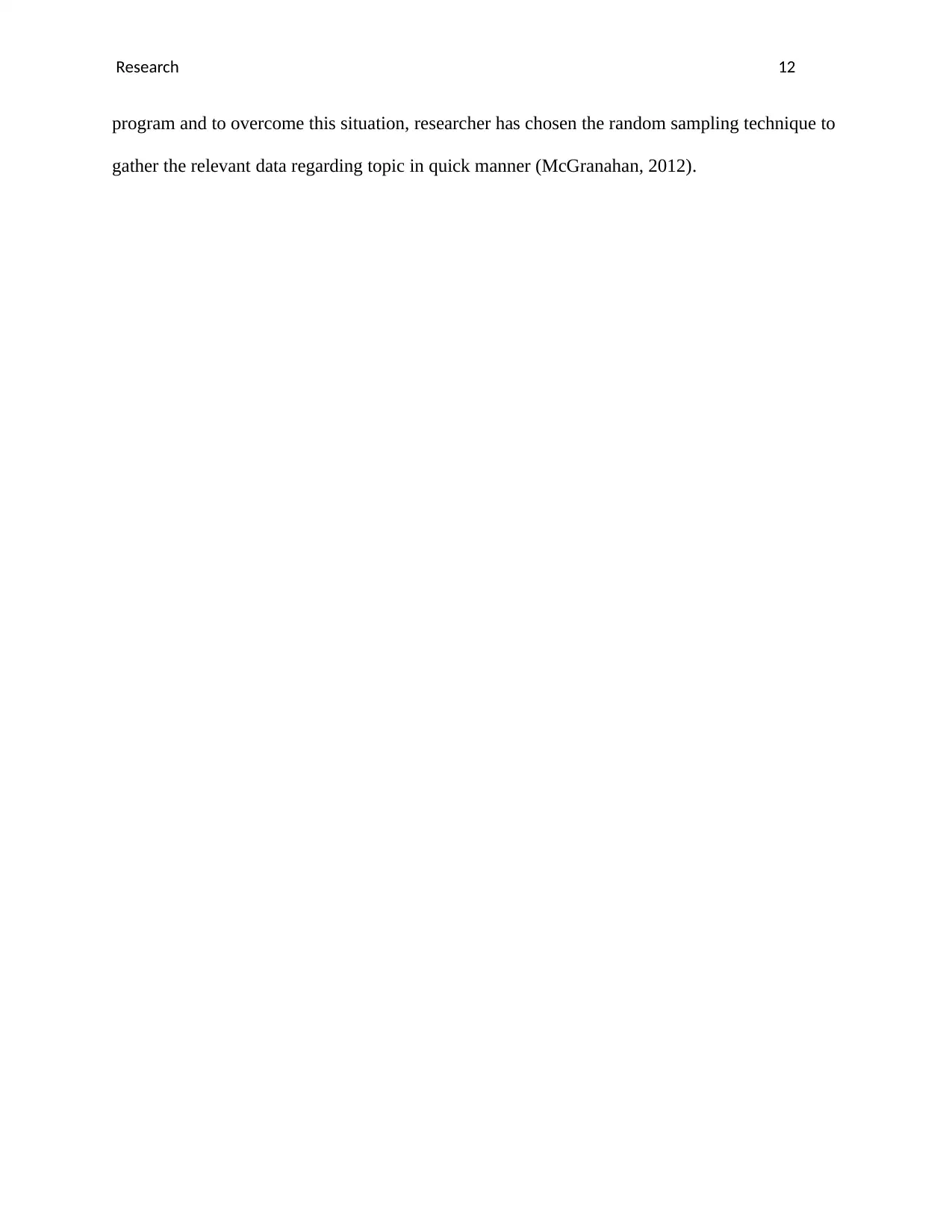
Research 12
program and to overcome this situation, researcher has chosen the random sampling technique to
gather the relevant data regarding topic in quick manner (McGranahan, 2012).
program and to overcome this situation, researcher has chosen the random sampling technique to
gather the relevant data regarding topic in quick manner (McGranahan, 2012).
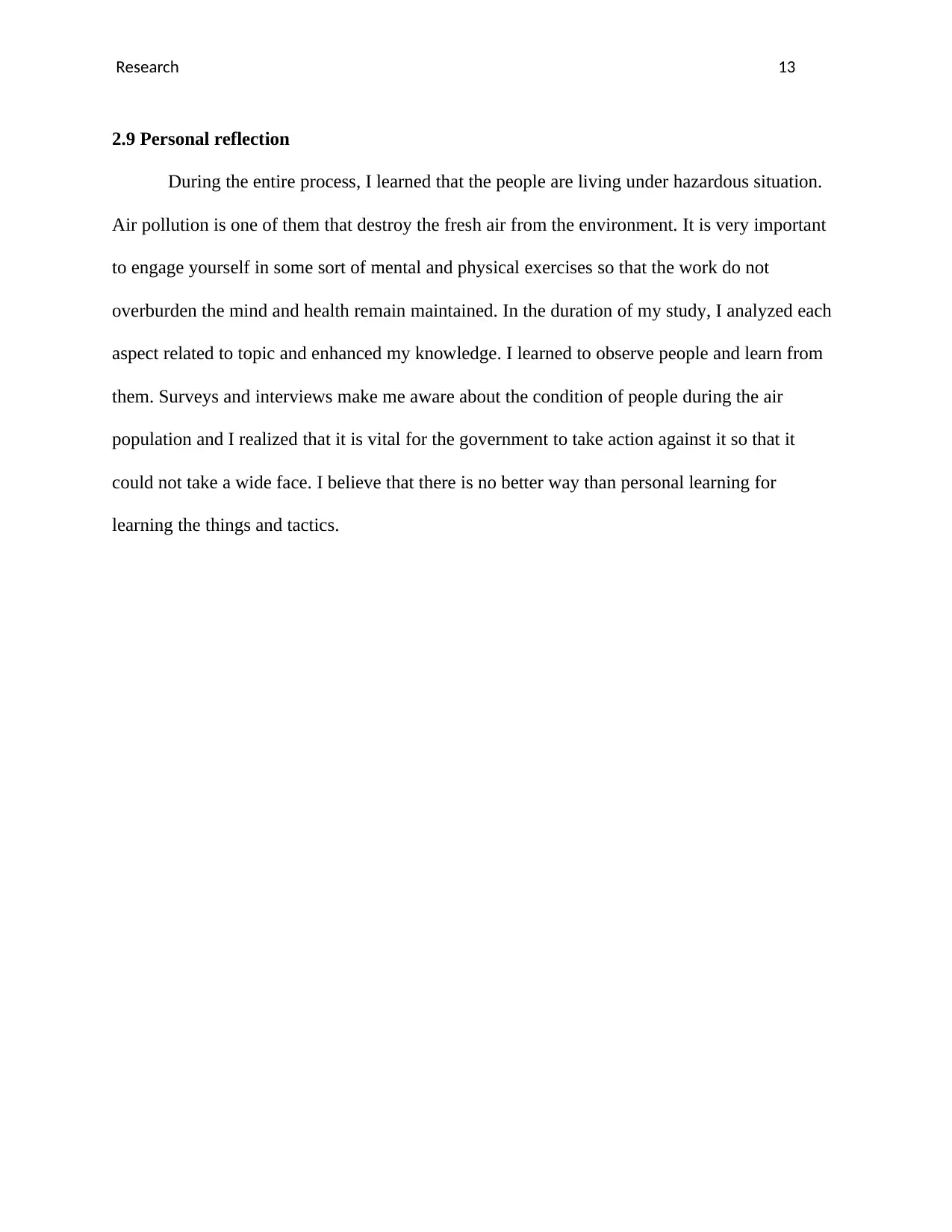
Research 13
2.9 Personal reflection
During the entire process, I learned that the people are living under hazardous situation.
Air pollution is one of them that destroy the fresh air from the environment. It is very important
to engage yourself in some sort of mental and physical exercises so that the work do not
overburden the mind and health remain maintained. In the duration of my study, I analyzed each
aspect related to topic and enhanced my knowledge. I learned to observe people and learn from
them. Surveys and interviews make me aware about the condition of people during the air
population and I realized that it is vital for the government to take action against it so that it
could not take a wide face. I believe that there is no better way than personal learning for
learning the things and tactics.
2.9 Personal reflection
During the entire process, I learned that the people are living under hazardous situation.
Air pollution is one of them that destroy the fresh air from the environment. It is very important
to engage yourself in some sort of mental and physical exercises so that the work do not
overburden the mind and health remain maintained. In the duration of my study, I analyzed each
aspect related to topic and enhanced my knowledge. I learned to observe people and learn from
them. Surveys and interviews make me aware about the condition of people during the air
population and I realized that it is vital for the government to take action against it so that it
could not take a wide face. I believe that there is no better way than personal learning for
learning the things and tactics.
Paraphrase This Document
Need a fresh take? Get an instant paraphrase of this document with our AI Paraphraser
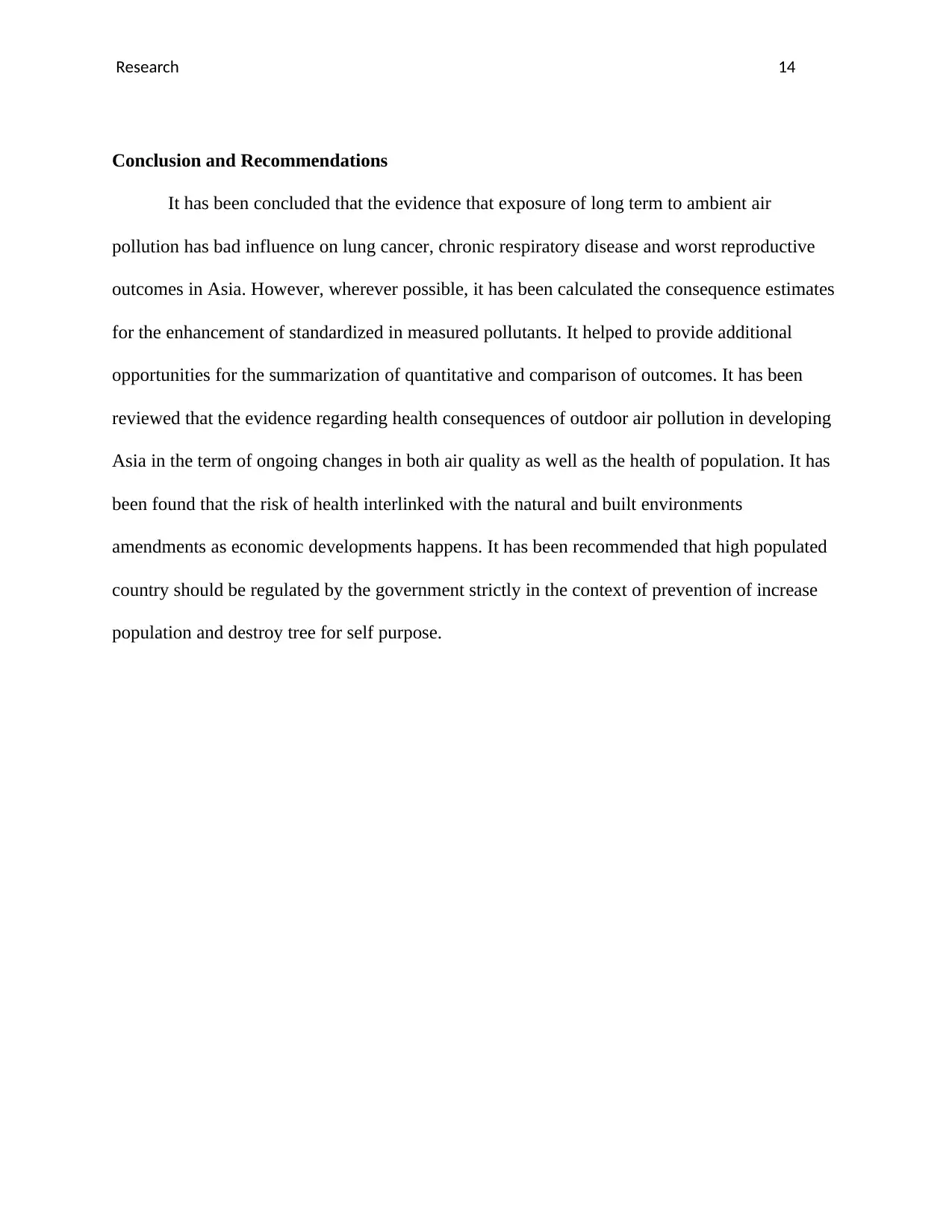
Research 14
Conclusion and Recommendations
It has been concluded that the evidence that exposure of long term to ambient air
pollution has bad influence on lung cancer, chronic respiratory disease and worst reproductive
outcomes in Asia. However, wherever possible, it has been calculated the consequence estimates
for the enhancement of standardized in measured pollutants. It helped to provide additional
opportunities for the summarization of quantitative and comparison of outcomes. It has been
reviewed that the evidence regarding health consequences of outdoor air pollution in developing
Asia in the term of ongoing changes in both air quality as well as the health of population. It has
been found that the risk of health interlinked with the natural and built environments
amendments as economic developments happens. It has been recommended that high populated
country should be regulated by the government strictly in the context of prevention of increase
population and destroy tree for self purpose.
Conclusion and Recommendations
It has been concluded that the evidence that exposure of long term to ambient air
pollution has bad influence on lung cancer, chronic respiratory disease and worst reproductive
outcomes in Asia. However, wherever possible, it has been calculated the consequence estimates
for the enhancement of standardized in measured pollutants. It helped to provide additional
opportunities for the summarization of quantitative and comparison of outcomes. It has been
reviewed that the evidence regarding health consequences of outdoor air pollution in developing
Asia in the term of ongoing changes in both air quality as well as the health of population. It has
been found that the risk of health interlinked with the natural and built environments
amendments as economic developments happens. It has been recommended that high populated
country should be regulated by the government strictly in the context of prevention of increase
population and destroy tree for self purpose.
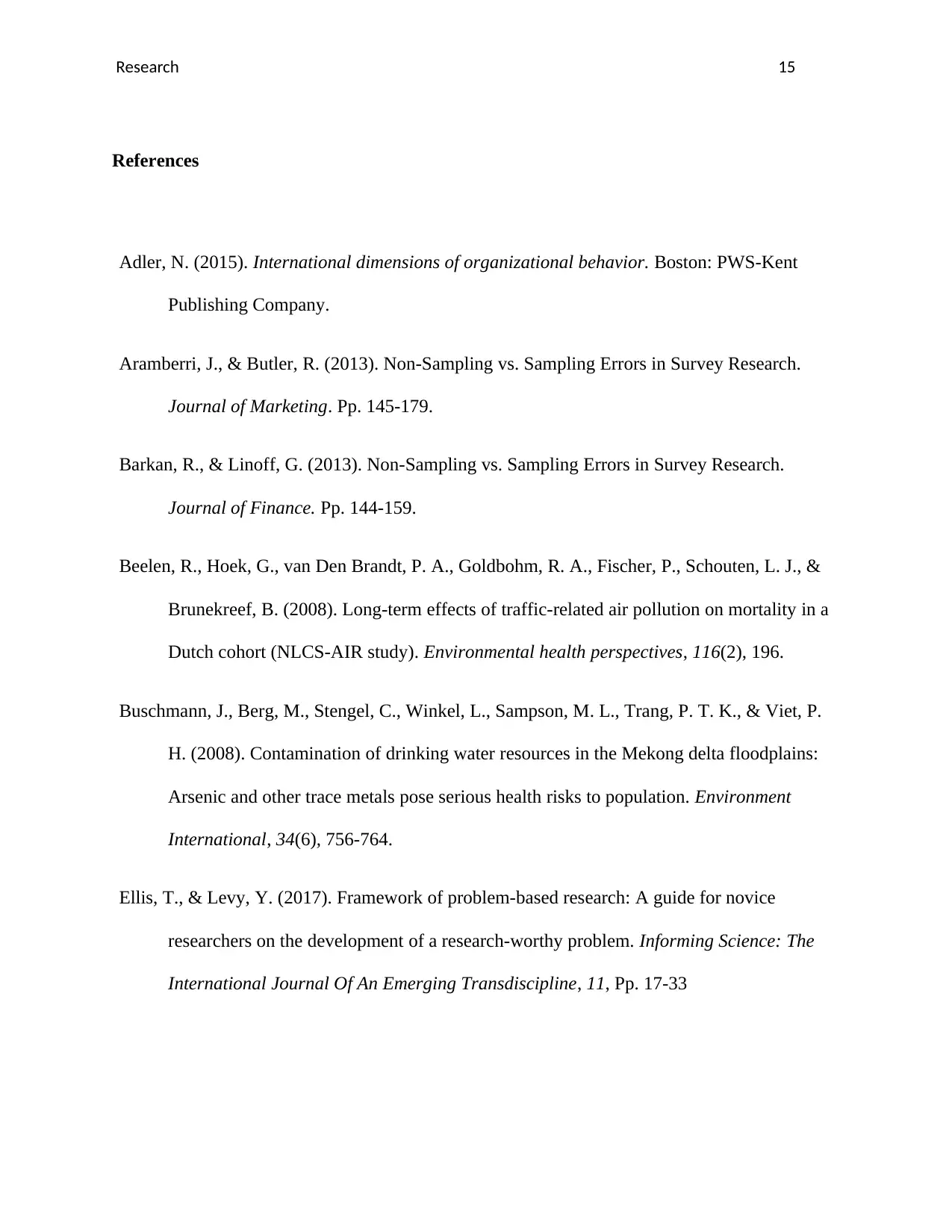
Research 15
References
Adler, N. (2015). International dimensions of organizational behavior. Boston: PWS-Kent
Publishing Company.
Aramberri, J., & Butler, R. (2013). Non-Sampling vs. Sampling Errors in Survey Research.
Journal of Marketing. Pp. 145-179.
Barkan, R., & Linoff, G. (2013). Non-Sampling vs. Sampling Errors in Survey Research.
Journal of Finance. Pp. 144-159.
Beelen, R., Hoek, G., van Den Brandt, P. A., Goldbohm, R. A., Fischer, P., Schouten, L. J., &
Brunekreef, B. (2008). Long-term effects of traffic-related air pollution on mortality in a
Dutch cohort (NLCS-AIR study). Environmental health perspectives, 116(2), 196.
Buschmann, J., Berg, M., Stengel, C., Winkel, L., Sampson, M. L., Trang, P. T. K., & Viet, P.
H. (2008). Contamination of drinking water resources in the Mekong delta floodplains:
Arsenic and other trace metals pose serious health risks to population. Environment
International, 34(6), 756-764.
Ellis, T., & Levy, Y. (2017). Framework of problem-based research: A guide for novice
researchers on the development of a research-worthy problem. Informing Science: The
International Journal Of An Emerging Transdiscipline, 11, Pp. 17-33
References
Adler, N. (2015). International dimensions of organizational behavior. Boston: PWS-Kent
Publishing Company.
Aramberri, J., & Butler, R. (2013). Non-Sampling vs. Sampling Errors in Survey Research.
Journal of Marketing. Pp. 145-179.
Barkan, R., & Linoff, G. (2013). Non-Sampling vs. Sampling Errors in Survey Research.
Journal of Finance. Pp. 144-159.
Beelen, R., Hoek, G., van Den Brandt, P. A., Goldbohm, R. A., Fischer, P., Schouten, L. J., &
Brunekreef, B. (2008). Long-term effects of traffic-related air pollution on mortality in a
Dutch cohort (NLCS-AIR study). Environmental health perspectives, 116(2), 196.
Buschmann, J., Berg, M., Stengel, C., Winkel, L., Sampson, M. L., Trang, P. T. K., & Viet, P.
H. (2008). Contamination of drinking water resources in the Mekong delta floodplains:
Arsenic and other trace metals pose serious health risks to population. Environment
International, 34(6), 756-764.
Ellis, T., & Levy, Y. (2017). Framework of problem-based research: A guide for novice
researchers on the development of a research-worthy problem. Informing Science: The
International Journal Of An Emerging Transdiscipline, 11, Pp. 17-33
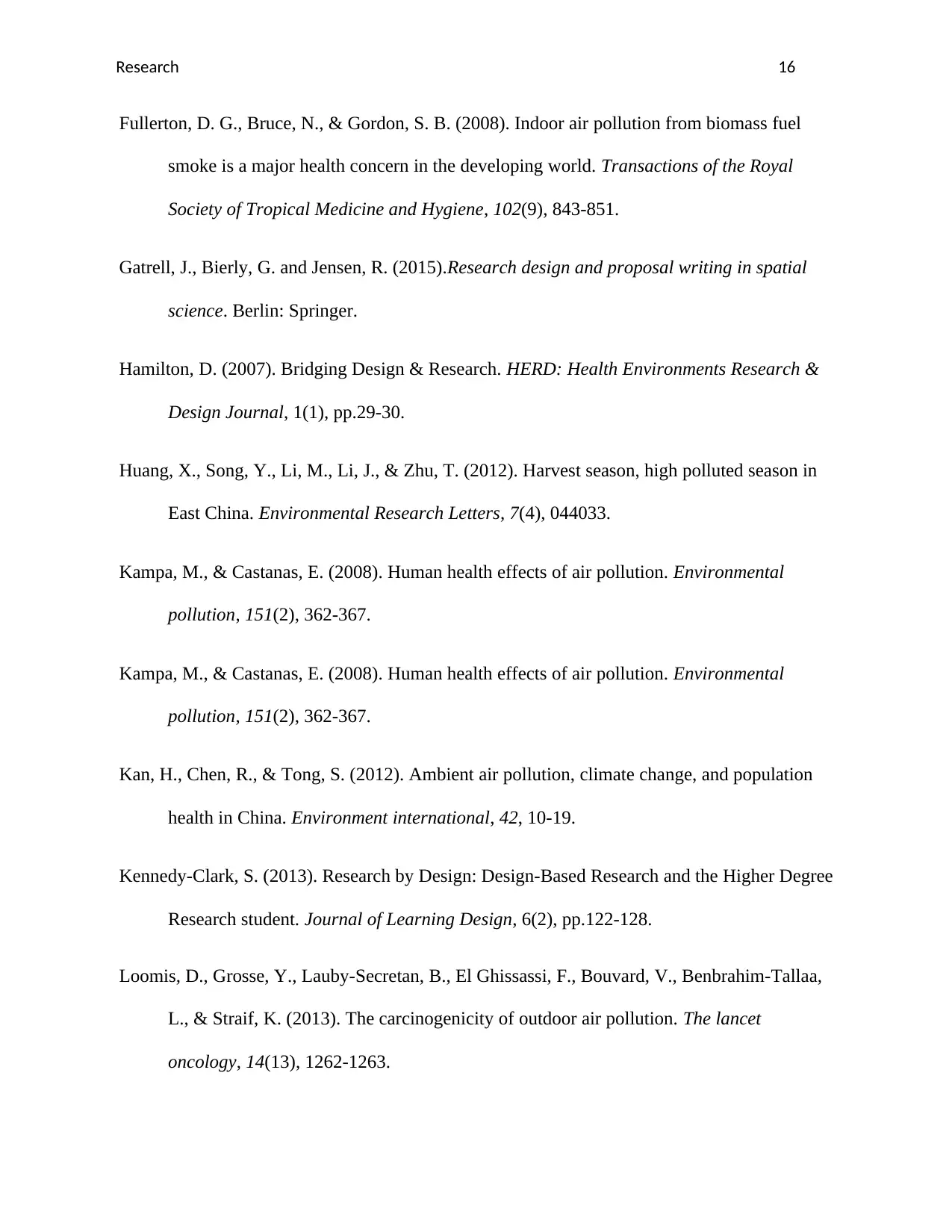
Research 16
Fullerton, D. G., Bruce, N., & Gordon, S. B. (2008). Indoor air pollution from biomass fuel
smoke is a major health concern in the developing world. Transactions of the Royal
Society of Tropical Medicine and Hygiene, 102(9), 843-851.
Gatrell, J., Bierly, G. and Jensen, R. (2015).Research design and proposal writing in spatial
science. Berlin: Springer.
Hamilton, D. (2007). Bridging Design & Research. HERD: Health Environments Research &
Design Journal, 1(1), pp.29-30.
Huang, X., Song, Y., Li, M., Li, J., & Zhu, T. (2012). Harvest season, high polluted season in
East China. Environmental Research Letters, 7(4), 044033.
Kampa, M., & Castanas, E. (2008). Human health effects of air pollution. Environmental
pollution, 151(2), 362-367.
Kampa, M., & Castanas, E. (2008). Human health effects of air pollution. Environmental
pollution, 151(2), 362-367.
Kan, H., Chen, R., & Tong, S. (2012). Ambient air pollution, climate change, and population
health in China. Environment international, 42, 10-19.
Kennedy-Clark, S. (2013). Research by Design: Design-Based Research and the Higher Degree
Research student. Journal of Learning Design, 6(2), pp.122-128.
Loomis, D., Grosse, Y., Lauby-Secretan, B., El Ghissassi, F., Bouvard, V., Benbrahim-Tallaa,
L., & Straif, K. (2013). The carcinogenicity of outdoor air pollution. The lancet
oncology, 14(13), 1262-1263.
Fullerton, D. G., Bruce, N., & Gordon, S. B. (2008). Indoor air pollution from biomass fuel
smoke is a major health concern in the developing world. Transactions of the Royal
Society of Tropical Medicine and Hygiene, 102(9), 843-851.
Gatrell, J., Bierly, G. and Jensen, R. (2015).Research design and proposal writing in spatial
science. Berlin: Springer.
Hamilton, D. (2007). Bridging Design & Research. HERD: Health Environments Research &
Design Journal, 1(1), pp.29-30.
Huang, X., Song, Y., Li, M., Li, J., & Zhu, T. (2012). Harvest season, high polluted season in
East China. Environmental Research Letters, 7(4), 044033.
Kampa, M., & Castanas, E. (2008). Human health effects of air pollution. Environmental
pollution, 151(2), 362-367.
Kampa, M., & Castanas, E. (2008). Human health effects of air pollution. Environmental
pollution, 151(2), 362-367.
Kan, H., Chen, R., & Tong, S. (2012). Ambient air pollution, climate change, and population
health in China. Environment international, 42, 10-19.
Kennedy-Clark, S. (2013). Research by Design: Design-Based Research and the Higher Degree
Research student. Journal of Learning Design, 6(2), pp.122-128.
Loomis, D., Grosse, Y., Lauby-Secretan, B., El Ghissassi, F., Bouvard, V., Benbrahim-Tallaa,
L., & Straif, K. (2013). The carcinogenicity of outdoor air pollution. The lancet
oncology, 14(13), 1262-1263.
Secure Best Marks with AI Grader
Need help grading? Try our AI Grader for instant feedback on your assignments.
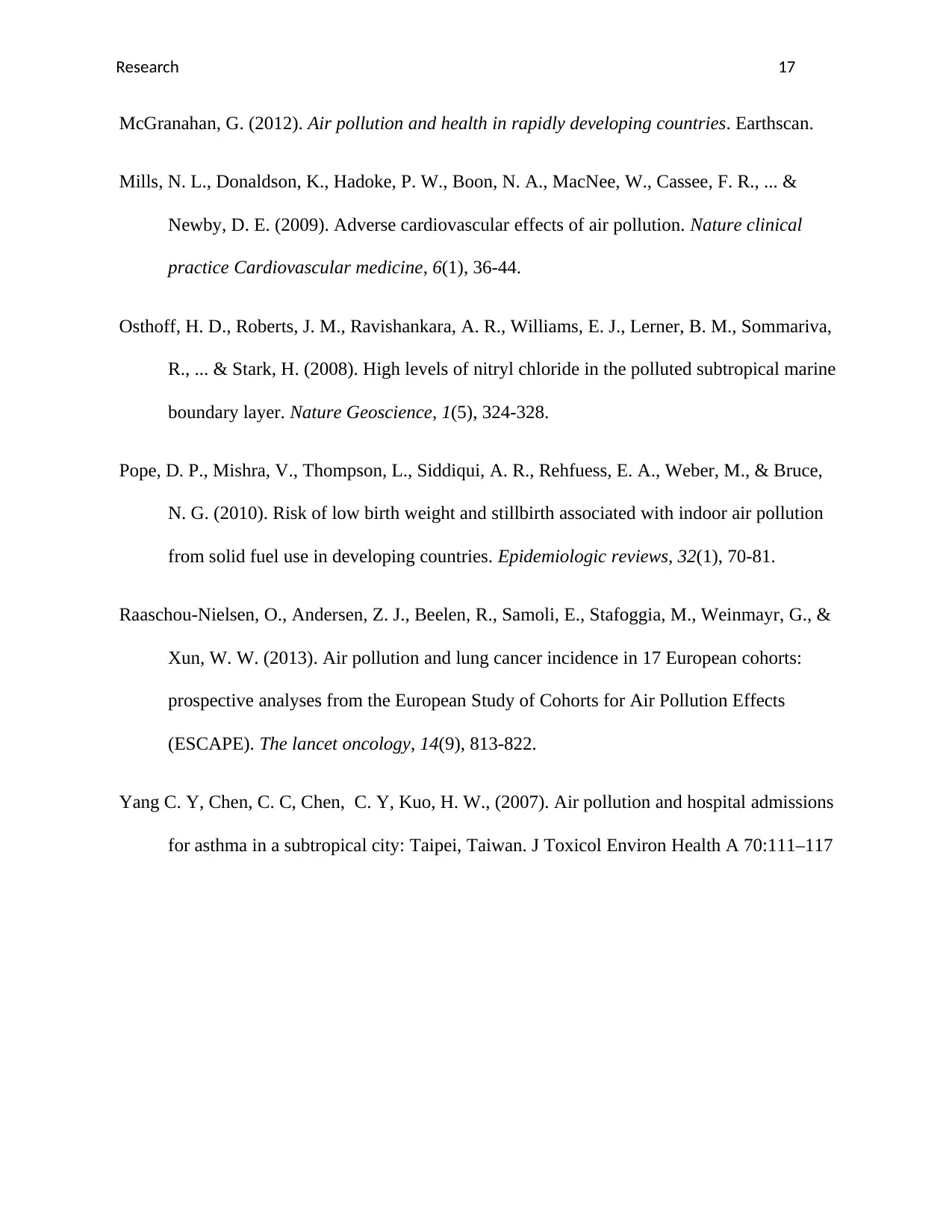
Research 17
McGranahan, G. (2012). Air pollution and health in rapidly developing countries. Earthscan.
Mills, N. L., Donaldson, K., Hadoke, P. W., Boon, N. A., MacNee, W., Cassee, F. R., ... &
Newby, D. E. (2009). Adverse cardiovascular effects of air pollution. Nature clinical
practice Cardiovascular medicine, 6(1), 36-44.
Osthoff, H. D., Roberts, J. M., Ravishankara, A. R., Williams, E. J., Lerner, B. M., Sommariva,
R., ... & Stark, H. (2008). High levels of nitryl chloride in the polluted subtropical marine
boundary layer. Nature Geoscience, 1(5), 324-328.
Pope, D. P., Mishra, V., Thompson, L., Siddiqui, A. R., Rehfuess, E. A., Weber, M., & Bruce,
N. G. (2010). Risk of low birth weight and stillbirth associated with indoor air pollution
from solid fuel use in developing countries. Epidemiologic reviews, 32(1), 70-81.
Raaschou-Nielsen, O., Andersen, Z. J., Beelen, R., Samoli, E., Stafoggia, M., Weinmayr, G., &
Xun, W. W. (2013). Air pollution and lung cancer incidence in 17 European cohorts:
prospective analyses from the European Study of Cohorts for Air Pollution Effects
(ESCAPE). The lancet oncology, 14(9), 813-822.
Yang C. Y, Chen, C. C, Chen, C. Y, Kuo, H. W., (2007). Air pollution and hospital admissions
for asthma in a subtropical city: Taipei, Taiwan. J Toxicol Environ Health A 70:111–117
McGranahan, G. (2012). Air pollution and health in rapidly developing countries. Earthscan.
Mills, N. L., Donaldson, K., Hadoke, P. W., Boon, N. A., MacNee, W., Cassee, F. R., ... &
Newby, D. E. (2009). Adverse cardiovascular effects of air pollution. Nature clinical
practice Cardiovascular medicine, 6(1), 36-44.
Osthoff, H. D., Roberts, J. M., Ravishankara, A. R., Williams, E. J., Lerner, B. M., Sommariva,
R., ... & Stark, H. (2008). High levels of nitryl chloride in the polluted subtropical marine
boundary layer. Nature Geoscience, 1(5), 324-328.
Pope, D. P., Mishra, V., Thompson, L., Siddiqui, A. R., Rehfuess, E. A., Weber, M., & Bruce,
N. G. (2010). Risk of low birth weight and stillbirth associated with indoor air pollution
from solid fuel use in developing countries. Epidemiologic reviews, 32(1), 70-81.
Raaschou-Nielsen, O., Andersen, Z. J., Beelen, R., Samoli, E., Stafoggia, M., Weinmayr, G., &
Xun, W. W. (2013). Air pollution and lung cancer incidence in 17 European cohorts:
prospective analyses from the European Study of Cohorts for Air Pollution Effects
(ESCAPE). The lancet oncology, 14(9), 813-822.
Yang C. Y, Chen, C. C, Chen, C. Y, Kuo, H. W., (2007). Air pollution and hospital admissions
for asthma in a subtropical city: Taipei, Taiwan. J Toxicol Environ Health A 70:111–117
1 out of 17
Related Documents
Your All-in-One AI-Powered Toolkit for Academic Success.
+13062052269
info@desklib.com
Available 24*7 on WhatsApp / Email
![[object Object]](/_next/static/media/star-bottom.7253800d.svg)
Unlock your academic potential
© 2024 | Zucol Services PVT LTD | All rights reserved.





